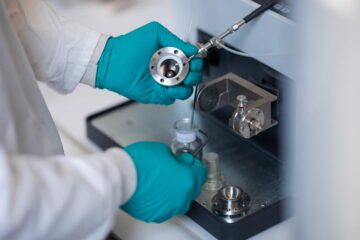Improved Fabrication of High Resolution Printed Circuit Boards (PCBs)

Through precise control of the etching process, an inventor in Oxford University’s Photofabrication Unit has made the reliable production of High Resolution Printed Circuit Boards (PCBs) with conductors down to 10 µm wide more of a cost-effective reality.
With increasing demands for greater miniaturisation and the use of flexible circuitry, the need for improved fabrication methods for high resolution printed circuit boards is becoming more important. PCBs currently include conductors with a width of 150 µm, but industry now requires conductors to be as narrow as 25 µm, and even as narrow as 10 µm. With current manufacturing techniques it is not possible to attain the required precision, especially where the spacing between the conductors varies. The etching rate is highest where the conductors are furthest apart, leading to over-etching and subsequent under-cutting of the very fine conductors in these areas. The resultant PCB has copper conductors of variable width, and therefore its performance is not optimum.
By controlling the etch conditions and the area to be etched, the Oxford inventor has reduced the amount of over-etching to an acceptable level, and under-cutting has been virtually eliminated. The spaces between the conductors are now all of uniform width, but with more redundant copper remaining on the PCB, resulting in the etching being confined to narrow tracks. In the magnified view of an actual PCB, the white areas represent the exposed copper tracks, while the black areas show the intervening non-conducting substrate.
This exciting new technology will benefit many of the applications that now demand PCBs with fine conductors or alternatively require flexible circuitry to facilitate yet further miniaturisation, including mobile phones, personal flip-top organisers and inkjet printers.
Isis Innovation, Oxford University’s technology transfer company, has filed a patent application for this technology and welcomes contact from companies interested in commercially developing this technique.
Media Contact
All latest news from the category: Process Engineering
This special field revolves around processes for modifying material properties (milling, cooling), composition (filtration, distillation) and type (oxidation, hydration).
Valuable information is available on a broad range of technologies including material separation, laser processes, measuring techniques and robot engineering in addition to testing methods and coating and materials analysis processes.
Newest articles

Security vulnerability in browser interface
… allows computer access via graphics card. Researchers at Graz University of Technology were successful with three different side-channel attacks on graphics cards via the WebGPU browser interface. The attacks…

A closer look at mechanochemistry
Ferdi Schüth and his team at the Max Planck Institut für Kohlenforschung in Mülheim/Germany have been studying the phenomena of mechanochemistry for several years. But what actually happens at the…

Severe Vulnerabilities Discovered in Software to Protect Internet Routing
A research team from the National Research Center for Applied Cybersecurity ATHENE led by Prof. Dr. Haya Schulmann has uncovered 18 vulnerabilities in crucial software components of Resource Public Key…





















